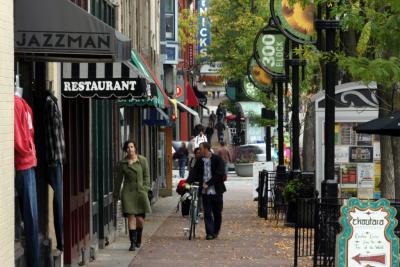
Urban life key to tackling climate change
A remedy for the inconvenient truth
Submitted on 11/16/2010. Tags for this image:CONCERN about climate change has ebbed with the global economic contraction.
Noble sacrifice seems less attractive to people fearing loss of a job.
So the political resolve to address global climate change has weakened. It wasn't so long ago that the consensus to act resolutely was deep and broad.
People compared the climate challenge to the disappearing ozone layer that spurred successful collective action by all nations to address an existential threat.
Opponents of climate action were viewed as strange, almost as odd as Holocaust deniers.
Now politicians, particularly on the Right, and energy industries have marshalled a full-blown counter-attack against advocates of action on global warming. Coupled with the recession, this campaign has stalled almost any government action on climate and energy in the US.
The Republican John McCain withdrew his support for a cap-and-trade system. US President Barack Obama and the Democrats barely mentioned climate change during the mid-term elections campaign. In Australia, the opposition, headed by a climate change sceptic, almost won the federal election.
It is tempting to attribute this situation solely to the greed of the oil barons or the cravenness of vote-hungry politicians, but I attribute part of the blame instead to three strategic errors.
The first error was to rely too heavily on existential and apocalyptic arguments. The ozone crisis was relatively simple, whereas climate change is complex and therefore it is easier to raise doubts about its severity.
The second error was to cast climate action as a moral obligation to sacrifice living standards today to save future generations. Actually, most energy-saving and CO2-reducing actions add efficiency to the economy and quickly help increase productivity.
The most effective argument against action on climate change is that it will hurt the economy and kill jobs.
By associating their cause with sacrifice, environmentalists handed this debating advantage to opponents on a silver platter.
The third error was to focus almost exclusively on technical remedies such as efficient light bulbs, hybrid cars and green buildings. That left out discussion of human settlement patterns, which account for most of the difference in energy consumption between areas of the developed world and those with much smaller footprints.
Specifically, the US with its spread-out development patterns and low usage of public transport and other alternatives to the car has an annual per capita energy consumption of 7900 oil equivalents, compared with 3775 equivalents for Europe with its more compact pattern.
With its hybrid development pattern, Australia clocks in at about 5900 equivalents per capita.
Although the former US vice-president Al Gore deserved his Nobel Prize and Oscar for the movie An Inconvenient Truth, he gave viewers a too narrow view of steps they could take.
His nine-item list of suggestions leaned heavily on small but significant changes we could make in our daily lives - changing to a more efficient light bulb, driving less, checking the pressure on our tyres, using less hot water, adjusting thermostats, and, naturally, buying his DVD.
Since then, progress has been made on installation of energy-efficient light bulbs and vehicle efficiency is improving again after a decade of backsliding.
One huge omission was how and where to build the more than 50 million new homes projected for the US by 2037.
Densely developed cities such as Sydney, Tokyo, London and New York rarely come to mind as models of environmentalism, but they should.
With people living closer to each other, walking more and taking advantage of public transport, cities have powerful environmental advantages.
A report prepared for New York Mayor Michael Bloomberg's green blueprint, PlaNYC, revealed that New Yorkers generate, on average, 7.1 tonnes of greenhouse gases a year, two-thirds less the average 24.5 tonnes generated by most Americans.
Of course, not everyone can be - or wants to be - a resident of New York. The good news is that a variety of walkable neighbourhoods helps reduce greenhouse gas emissions.
A 2002 peer-reviewed study by John Holtzclaw compared driving patterns across metro Chicago, Los Angeles and San Francisco.
It showed that kilometres driven by an average household dropped between 32 per cent and 43 per cent as the density of neighbourhoods doubled.
In other words, in moving from a typical ex-urban neighbourhood with 7.2 units per hectare to a leafy neighbourhood of townhouses and low-rise apartment buildings where densities are at least 57to the hectare, a household would reduce its driving to about one-third of their former levels.
A move to the tight-knit heart of Surry Hills or Darlinghurst near Sydney would yield about a 50 per cent reduction.
With a switch to far more efficient transport for some of their trips and walking for some others, that's a big reduction in the annual tonnage of carbon a household sends into our atmosphere.
At the moment, the freedom to fire up a backyard barbecue or to load up a car or ute and hit the road are an assumed "national lifestyle" of the US and Australia, and that's not necessarily the problem. The problem is how much you use that ute.
In the next 30 years, Americans and Australians will build tens of millions of new dwellings. It's looking as if building a good portion of them in liveable, walkable traditional neighbourhoods is one of the most convenient - and effective - remedies for the inconvenient truth.
This article is crossposted on The Australian.


